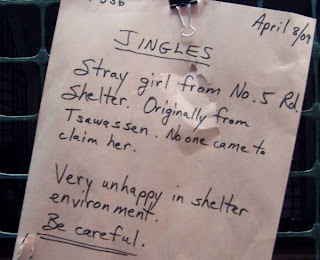Maybe Chance (aka Last Chance) was once a cute cat, a pretty cat, a regal cat, but we've only known him looking a bit of a furry disaster.
(Last) Chance
drawing by Claire
His feature in The Love Blog describes how he was brought in after one of the volunteers repeatedly came across this tattered stray in the neighborhood. The volunteer was moving away and wanted to make sure he'd be cared for.
Google trivia: seaching "scruffy stray cat" yields 36,000 results.
Meaning - our tatty friend Chance is not alone. If anything, the scruffy stray is something of an archetype. One of my Google results was for a book by Erica Silverman called Mrs. Peachtree and the Eighth Avenue Cat.
"In old New York City, where the streets are lit by lamplight, Mrs. Peachtree owns a tea shop on Eighth Avenue. Although she feigns dislike for the stray cat that is lurking about, she feeds and rescues him from the wheels of a wagon. So when he doesn't show up at mealtime one dark and stormy night, it is no great surprise when she searches the streets for him. Sadly, she returns home alone. The next day, though, the animal jumps out from behind some tins of tea and firmly into her heart." - Susan Pine, New York Public LibraryOn the other end of the literary scale can be found Natsume Soseki's comic novel I Am a Cat (吾輩は猫である), which uses a stray cat protagonist to describe and satirize middle class society in Meiji era Japan.
Being friendly and approachable rather than pretentious and diffident, our Chance fits the children's book novel much better than the literary satire. For him and his tough street cat days, I'd like to dedicate a song: Stray Cats' Stray Cat Strut (on YouTube).
And finally, for anyone who thinks a cat they've seen around might be a stray and isn't sure how to help, check out these websites:













































